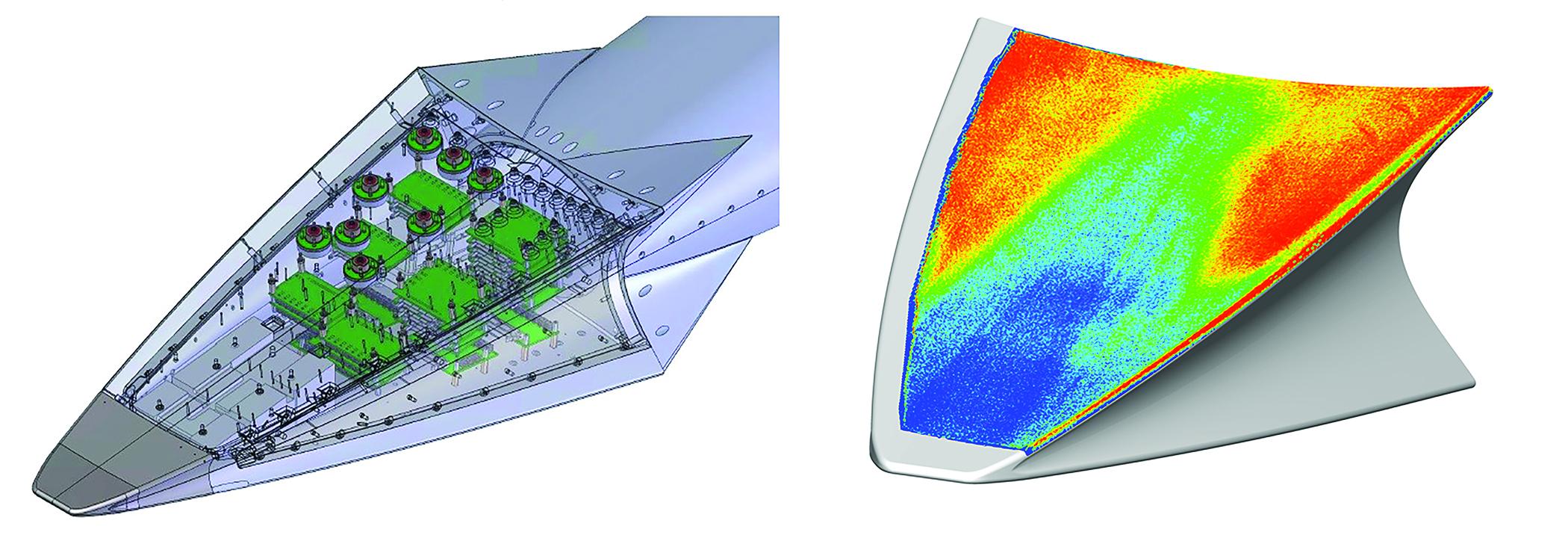極超音速飛行試験、準備が本格化 | Hypersonic Flight Testing Preparations Ramp Up

アメリカの極超音速システム開発者、特に次世代の大型機担当者にとっては、政府・教育機関・業界が所有する地上試験施設への再投資が続いているにも関わらず、試験が大きな課題となっている。
Lockheed Martin社のMissiles and Fire Control部門で技術担当ディレクターを務めるDavid Hunn氏は、11月にロンドンで行われた王立航空協会の極超音速会議で「望む条件すべてについて試験をすることはできない」と話した。基本的な試験条件であるエンタルピー・熱流・圧力・酸素含量の4つについて、これらを同時に試験できる施設はアメリカの開発者がアクセスできる範囲には存在しない。これにより、必然的に飛行試験が重視されることになり、地上試験および不確実性に対する安全マージンの追加で補完することになる。
Hunn氏が「空飛ぶ風洞試験場」と称した、X-43A・X-51A・DARPA主導のHTV-2ファルコンといった機体の過去の飛行試験は貴重なデータを残した。たとえば、2010年・2011年に行われたHTV-2の試験では、マッハ16程度での飛行時のデータを540秒分残した。「 通信途絶するまでの間、非常に興味深い空力および素材に関するデータを集めることができた」と彼は語った。
直近で予定されている飛行試験は、米空軍研究所(AFRL)のX-60Aだ。この機体は液体酸素/ケロシンを燃料とする空中発射型のロケットで、マッハ5~8という極超音速域で搭載品を試験するために設計されている。改造されたガルフストリーム社製ビジネス機から投下されるこの使い捨てロケットは、機動を可能とするための翼と、データ収集のためのテレメトリーシステムを搭載している。Generation Orbit Launch Services社によって開発されたX-60Aは、2021年春にフロリダ州ジャクソンビルにあるセシル宇宙港で最初の飛行試験を行う予定だ。
もうひとつAFRLによる試験飛行が近付いているのは、ジョンズ・ホプキンス大学応用物理学研究所が主導する境界層遷移(Boundary Layer Transition:BOLT)の飛行試験だ。これはロケットに搭載され、複雑なジオメトリの中で流動特性を計測するために開発されている。成功裏に終わったアメリカ・オーストラリア合同のHIFiRE飛行試験の結果を元に、今回の試験では今後の大型機の形状に近い、大きく湾曲した頂点を持つ低曲率凹面上の境界層遷移を計測する。
サウンディングロケットにより高度280km(174マイル)まで上昇すると、機材を満載したBOLTはまず上昇中にマッハ4.7~6の間で最初の計測を行い、続いて降下の最後の数秒でマッハ6.7~7.4の間で計測を行う。高度15km地点でBOLTはブースターから切り離され、フラットスピンに入る。こうして速度を落とすことで、落下後の検証を可能にする。当初5月に予定されていたこの試験はコロナ危機により8月に延期され、さらに2021年初頭に予備日が設定されている。試験はスウェーデンのキルナ近郊にある、Swedish Space Corporation社のエスレンジ発射場で行われる。
アメリカで初期の極超音速飛翔機や巡航ミサイルの飛行試験が加速し、空軍だけで今後4年間に40機の発射が予定されている中で、民間企業も参入に向けて準備を進めている。そのなかのひとつであるStratolaunch社は、もともと中型ロケットを空中発射するために開発した巨大な発射母機を、極超音速機の飛行試験を支援するプラットフォームとして再活用する計画を発表した。
今年後半からカリフォルニア州のモハベにある拠点での飛行試験を再開させたい同社は、一連の試験機による試験を計画している。タロンAは完全に再使用が可能・自動操縦・液体燃料ロケットを搭載した機体で、マッハ6を目標としている。続いて、マッハ10を目標とするタロンZ、そして長期目標としての「ブラックアイス」スペースプレーンがある。
アトランタに拠点を置くもうひとつのプライベートベンチャー・Hermeus社は、マッハ5を実現するタービンベース複合サイクル(TBCC)エンジンプロトタイプの静止試験および研究所内での高速試験を完了し、短期計画に基づくエンジンモードの切り替え試験を行うべく、作業を進めている。同社は既存もしくは近いうちに使用可能になる機体・素材・システム・推進技術をベースにした高速輸送システムを2020年代末までに開発することを目指している。
DARPAと空軍は合同で、TBCCシステムの構成要素であるAdvanced Full-Range Engine (AFRE)の地上試験を独自に進めている。これは将来の滑走路を用いる再使用型極超音速スペースシップ向けに開発され、最大マッハ5での運用を想定している。AFREは既存のジェットエンジンとデュアルモードラムジェット/スクラムジェットを複合使用する設計だ。
このエンジンはマスインジェクション・プレコンプレッサー冷却方式を採用することで、タービンの最高速とラムジェットが引き継ぐ速度の間のギャップを埋めている。その心臓部にあるウォーターインジェクション装置と、一般的なタービン/DMRJ吸気口、コンバスター、一般的なノズルは、今年後半には組み合わされ、完全なTBCCアッセンブリを完成させる。フリージェット試験は2021年の予定だ。
NASAが長期にわたって進めている極超音速テクノロジー計画もTBCCコンセプトの研究のために継続されており、6月にはGE Aviation社と共同でコンポーネント部品向けの高温セラミックマトリックス複合素材を開発することを表明した。また、NASAはTBCCを搭載するコンセプト機の研究のための分析用に、GE社のF101ターボファンエンジンを選定した。
以上は、Guy Norrisが Aviation Week & Space Technologyいた記事です。 Aviation Week & Space Technology は、豊富な経験と人脈を持った専門家により、最新トレンドや最適な状況判断、ポリシー・要求仕様・予算に関する充実した情報を継続的にお届けします。 Aviation Week & Space Technology をもっと知りたい場合、こちらをクリックして下さい。
Testing remains a key challenge for U.S. hypersonic developers, particularly those looking to produce the next generation of larger vehicles, despite a recent wave of reinvestment in government, academic and industrial ground-test facilities.
“We can’t test at all the conditions I want,” said David Hunn, director of technology at Lockheed Martin Missiles and Fire Control, speaking at a Royal Aeronautical Society hypersonics conference in London in November. Of the basic test conditions—enthalpy, heat flux, pressure and oxygen content—there is no test site open to U.S. developers where all four can be evaluated simultaneously. This inevitably puts a greater focus on flight tests for qualifying vehicles, backed up by ground tests and the addition of margin for uncertainties.
The “wind tunnels in the sky,” as Hunn described previous U.S. tests such as the X-43A, X-51A and DARPA-led HTV-2 Falcon, have produced invaluable data. The HTV-2 reentry vehicles, for example, tested in 2010 and 2011, generated 540 sec. of data at around Mach 16. “We got very interesting aerodynamic and materials data on those vehicles before they came to their untimely end,” he said.
A flying testbed planned for the near term is the U.S. Air Force Research Laboratory’s (AFRL) X-60A, an air-launched liquid oxygen/kerosene-powered rocket that is designed to test payloads at hypersonic speeds from Mach 5-8. The expendable vehicle, which will be dropped from a modified Gulfstream business aircraft, is configured with wings for maneuverability and an onboard flight telemetry system for data capture. Developed by Generation Orbit Launch Services, the X-60A is now expected to make its initial test flight out of Cecil Spaceport, Jacksonville, Florida, in spring 2021.
Another impending AFRL hypersonic flight test, this time led by the Johns Hopkins University Applied Physics Laboratory, is the Boundary Layer Transition (BOLT) flight experiment—a rocket-launched payload designed to evaluate flow characteristics over complex geometries. Building on the results of earlier tests as part of the successful U.S.-Australian HIFiRE flight series, the experiment will measure boundary-layer transition on a low-curvature concave surface with highly swept leading edges—a shape more relevant to future large-scale vehicles.
Boosted by a sounding rocket to just over 280 km (174 mi.) altitude, the heavily instrumented BOLT payload will conduct the first experiment on ascent between Mach 4.7-6, and in the final few seconds of descent, between Mach 6.7-7.4. At an altitude of 15 km the payload will be separated from the booster to allow it to enter a flat spin—slowing its velocity before impact and enabling it to be inspected after recovery. The test, which was delayed from May by the COVID-19 pandemic, has been rescheduled for August with a backup date in early 2021. It will be conducted at the Swedish Space Corporation’s Esrange near Kiruna, Sweden.
As flight tests of initial hypersonic glide vehicles and cruise missiles accelerate in the U.S., with 40 individual launches planned over the next four years by the Air Force alone, private industry is stepping up efforts to enter the fray. One company, Stratolaunch, has outlined plans to repurpose its huge carrier aircraft—originally designed to air-launch medium rockets—into a platform to support hypersonic flight tests.
Stratolaunch, which aims to resume flight tests at its Mojave, California, base later this year, plans a series of flying testbeds starting with the Talon-A, a fully reusable, autonomous, liquid rocket-powered vehicle targeted at flight speeds up to Mach 6. This will be followed by the Talon-Z, targeted at test conditions up to Mach 10, and the longer-term “Black Ice” spaceplane.
Another private venture, Atlanta-based Hermeus, has completed scaled static and high-speed laboratory tests of a prototype turbine-based combined-cycle (TBCC) engine up to Mach 5, and is working on near-term plans to test the transition between engine modes. The company aims to develop a high-speed transport for entry into service around the end of this decade based on existing and near-term airframe, materials, systems and propulsion technologies.
DARPA, together with the Air Force, is meanwhile conducting individual ground tests of elements of a TBCC system called the Advanced Full-Range Engine (AFRE). Designed for future runway-based reusable hypersonic vehicles operating up to Mach 5, the AFRE combines an off-the-shelf turbine and dual-mode ramjet/scramjet (DMRJ).
The engine uses mass-injection precompressor cooling to close the gap between the maximum speed of the turbine and the takeover speed of the ramjet. The water injection element at the heart of this, together with the common turbine/DMRJ inlet, combustor and common nozzle will be integrated later this year into the complete TBCC assembly. Free-jet testing of the engine is set to occur in 2021.
NASA’s long-running Hypersonic Technology Project also continues to study a TBCC concept, and in June announced it will work with GE Aviation to develop high-temperature ceramic matrix composite materials for component parts. NASA also selected GE’s F101 turbofan for analysis as part of studies of a TBCC-powered concept vehicle.



